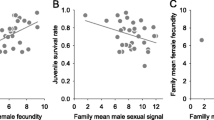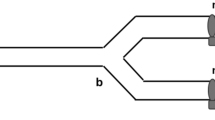Abstract
AN important problem in evolutionary biology since the time of Darwin has been to understand why females preferentially mate with males handicapped by secondary sexual ornaments1–3. One hypothesis of sexual selection theory is that these ornaments reliably reveal the male's condition4–6, which can be affected for example by parasites4,7–13. Here we show that in the three-spined stickleback (Gasterosteus aculeatus) the intensity of male red breeding coloration positively correlates with physical condition. Gravid females base their active mate choice on the intensity of the male's red coloration. Choice experiments under green light prevent the use of red colour cues by females, and males that were previously preferred are now chosen no more than randomly, although the courtship behaviour of the males remains unchanged. Parasitieation causes a deterioration in the males' condition and a decrease in the intensity of their red coloration. Tests under both lighting conditions reveal that the females recognize the formerly parasitized males by the lower intensity of their breeding coloration. Female sticklebacks possibly select a male with a good capacity for paternal care14 but if there is additive genetic variation for parasite resistance, then they might also select for resistance genes, as proposed by Hamilton and Zuk4.
Similar content being viewed by others
References
Bradbury, J. W. & Andersson, M. B. (eds) Sexual Selection: Testing the Alternatives (Wiley, New York, 1987).
Kirkpatrick, M. Ann. Rev. Ecol. Syst. 18, 43–70 (1987).
Maynard-Smith, J. J. theor. Biol. 115, 1–8 (1985).
Hamilton, W. D. & Zuk, M. Science 218, 384–387 (1982).
Zahavi, A. J. theor. Biol. 53, 205–214 (1975).
Andersson, M. Biol. J. Linn. Soc. 17, 375–393 (1982).
Read, A. F. Nature 328, 68–70 (1987).
Ward, P. I. Anim. Behav. 36, 1210–1215 (1988).
Ward, P. I. Oikos 55, 428–429 (1989).
Read, A. F. & Harvey, P. H. Nature 339, 618–620 (1989).
Pomiankowski, A. Nature 338, 115–116 (1989).
Endler, J. A. & Lyles, A. M. Trends Ecol. Evol. 4, 246–248 (1989).
Read, A. Trends Ecol. Evol. 3, 97–101 (1988).
Heywood, J. S. Evolution 43, 1387–1397 (1989).
Brush, A. H. & Reisman, H. M. Comp. Biochem. Physiol. 14, 121–125 (1965).
Semler, D. E. J. Zool. 165, 291–302 (1971).
Endler, J. A. Evolution 34, 76–91 (1980).
Endler, J. A. Env. Biol. Fish. 9, 173–190 (1983).
Kodric-Brown, A. Behav. Ecol. Sociobiol. 17, 199–205 (1985).
Houde, A. E. Evolution 41, 1–10 (1987).
Houde, A. E. Anim. Behav. 36, 510–516 (1988).
Kennedy, C. E. J., Endler, J. A., Poynton, S. L. & McMinn, H. Behav. Ecol. Sociobiol. 21, 291–295 (1987).
Bischoff, R. J., Gould, J. L. & Rubenstein, D. I. Behav. Ecol. Sociobiol. 17, 253–255 (1985).
Wootton, R. J. The Biology of the Sticklebacks (Academic, London, 1976).
ter Pelkwijk, J. J. & Tinbergen, N. Z. Tierpsychol. 1, 193–200 (1937).
van lersel, J. J. A. Behaviour Suppl. 3, 1–159 (1953).
Sevenster, P. Behaviour Suppl. 9, 1–170 (1961).
Sokal, R. R. & Rohlf, F. J. Biometry 2nd edn (Freeman, New York, 1981).
Long, K. D. & Houde, A. E. Ethology 82, 316–324 (1989).
Smyth, J. D. Introduction to Animal Parasitology (Hodder and Stoughton, London, 1985).
Reisman, H. M. Copeia 1968, 816–826 (1968).
Bakker, T. C. M. Behaviour 98, 1–144 (1986).
McLennan, D. A. & McPhail, J. D. Can. J. Zool. 67, 1767–1777 (1989).
Cronly-Dillon, J. & Sharma, S. C. J. exp. Biol. 49, 679–687 (1968).
McCallum, H. I. Parasitology 85, 475–488 (1982).
Price, D. J. J. Fish Biol. 26, 509–519 (1985).
Bolger, T. & Connolly, P. L. J. Fish Biol. 34, 171–182 (1989).
Miller, R. G. Jr Beyond ANOVA, Basics of Applied Statistics (Wiley, New York, 1986).
Author information
Authors and Affiliations
Rights and permissions
About this article
Cite this article
Milinski, M., Bakker, T. Female sticklebacks use male coloration in mate choice and hence avoid parasitized males. Nature 344, 330–333 (1990). https://doi.org/10.1038/344330a0
Received:
Accepted:
Issue Date:
DOI: https://doi.org/10.1038/344330a0
- Springer Nature Limited
This article is cited by
-
Parasitism in viviparous vertebrates: an overview
Parasitology Research (2024)
-
Coexistence with an invasive species in the context of global warming lead to behavioural changes via both hereditary and ontogenetic adjustments to minimise conflict
acta ethologica (2023)
-
Relationships between male secondary sexual traits, physiological state and offspring viability in the three-spined stickleback
BMC Ecology and Evolution (2022)
-
Hybrid confocal fluorescence and photoacoustic microscopy for the label-free investigation of melanin accumulation in fish scales
Scientific Reports (2022)
-
Multimodal female mate choice in a polymorphic flat rock lizard
Behavioral Ecology and Sociobiology (2022)





